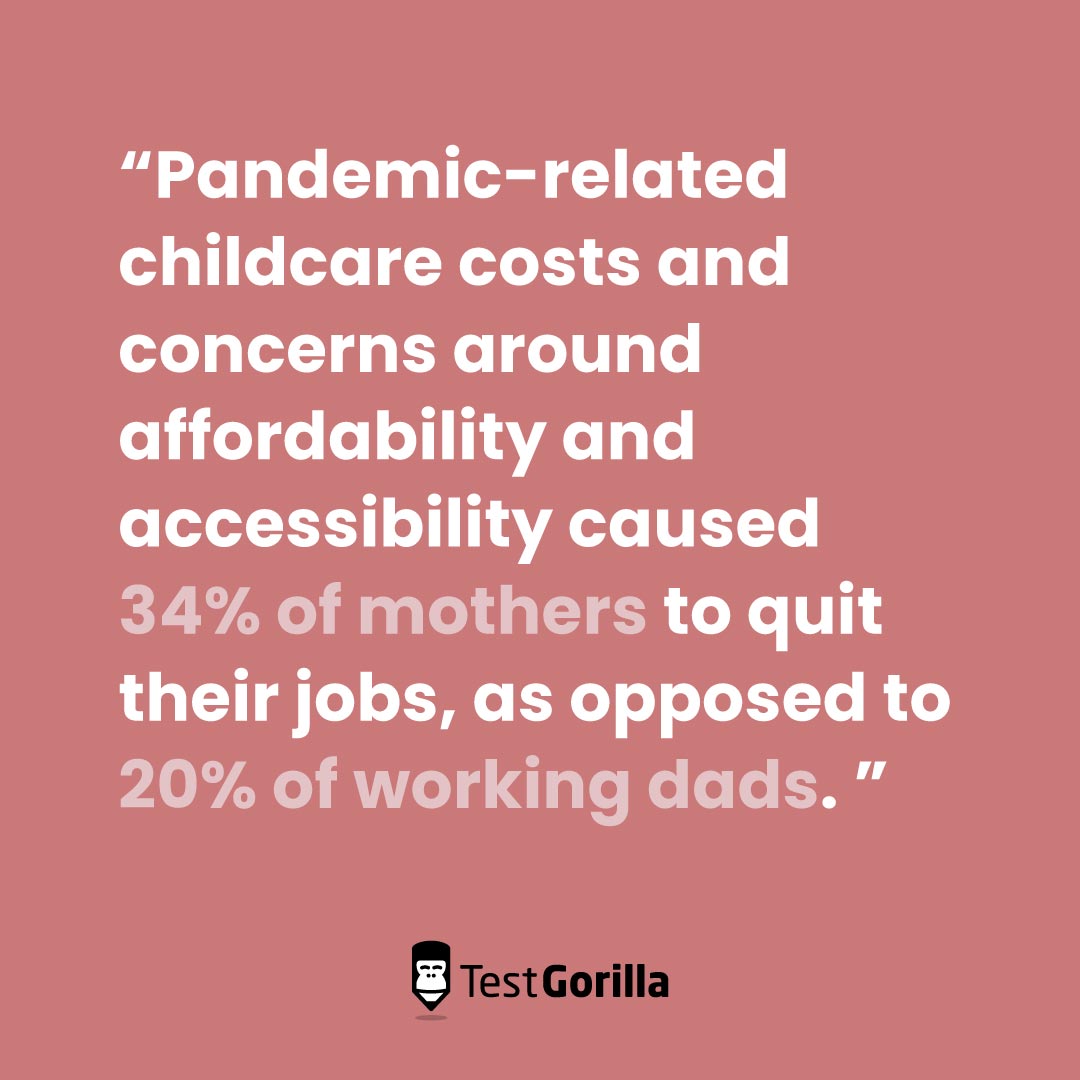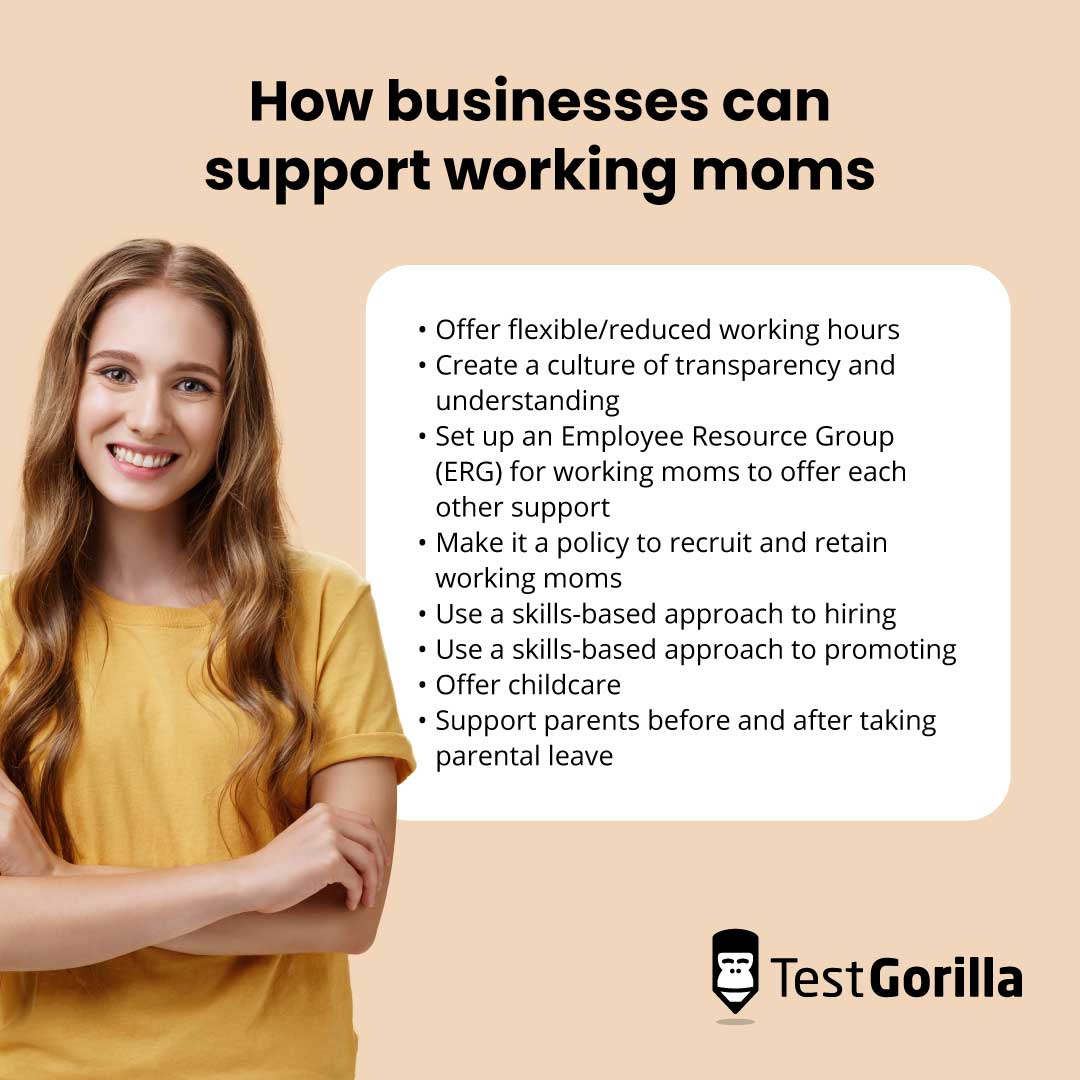Having it all or just doing it all? Supporting 21st-century moms at work
Whoever said working moms can’t have it all was clearly not a working mom. In fact, working moms don’t just have it all with a career and a family, they very often end up doing it all, too.
Whether it’s picking up kids from school, organizing playdates, or booking medical appointments, moms tend to do more of these ‘hidden’ tasks than dads.[1] And that’s on top of trying to advance their career while taking maternity leave during the years they’re most likely to move up the career ladder.
Today, many working mothers report burnout due to the unequal demands of home and work, and either quit their jobs or look for less demanding roles[2].
But companies with more female executives perform better and have a higher profit margin.[3] In this piece, we’ll examine the challenges facing working moms in 2023 — based on interviews with working mothers. We’ll also look at what employers can do to support them.
The hidden burden of working moms
Research shows that even when partners split their work/life responsibilities 50/50, women still end up with more ‘hidden care’ duties. Ranging from going to parent-teacher meetings to maintaining and anticipating family emotions — a bulk of their added responsibilities largely go unnoticed.
We spoke to Kim Severinsen, head of assessments at TestGorilla, about the hidden burden of working moms:
“You can have it all as a mother. But your grades will suffer. Forget keeping your straight A average. If you’re an A at home, you’re probably a B or C at work. And if you’re an A at work, someone or something at home is missing out – and that might include yourself. You’re going to have to get comfortable with B’s.”
With all the added behind-the-scenes work, more than 9.8 million working mothers surveyed in 2020 reported suffering from burnout. And to better balance the load, they look for part-time work or less demanding roles.
And then came the pandemic
The pandemic further complicated the situation. While women gained more flexibility to work from home, they also ended up doing a greater portion of childcare and homeschooling – even with both parents present and working remotely.
On top of that, pandemic-related childcare costs and concerns around affordability and accessibility caused 34% of mothers to quit their jobs, as opposed to 20% of working dads.
If employers understand the work that goes on behind-the-scenes, it can help redistribute it more fairly. This might be challenging at first, but it could play a significant role in leveling the playing field for women in the workforce, specifically in remote and hybrid environments.
The best insights on HR and recruitment, delivered to your inbox.
Biweekly updates. No spam. Unsubscribe any time.
Why companies should strive to support working moms
In our 2022 State of Skills-based Hiring report, we cite a McKinsey study that found gender-diverse teams are 25% more likely to financially outperform less diverse companies.
This means that, to stay competitive, you need to better support working moms. By attracting and retaining this group of workers, you can build a more diverse team and create a company culture that encourages all employees to do their best work.
How businesses can support working moms
Research shows that companies with female leadership perform better than those dominated by men. So it’s important to support women and working mothers in the workplace to stay ahead.
Here are some best practices you can use to support working moms, outperform your competitors, and win the war for talent.
Offer flexible/reduced working hours
To reward and retain top talent, you need to offer flexible working hours. Especially in a remote or hybrid work environment where the demands of life outside of work easily blend into your day-to-day schedule. As mentioned above, this is important for working moms.
With the motherhood penalty at play, working mothers need flexible hours that let them better manage their work-life responsibilities. When they can manage their time and tasks to suit their needs, they’re more likely to focus on work without distractions. And flexible working adds to a more people-centric work culture built on trust.
Create a culture of transparency and understanding
Creating psychological safety in the workplace is important to hiring and retaining mothers. They need to know they can come to you for support and understanding when they have a lot on their plate. And without fear they’ll get overlooked for promotion or be the first in line for layoffs.
According to a Deloitte study cited in our report, 83% of millennial employees are more actively engaged at work when they believe their organization enables an inclusive culture, but only 60% are actively engaged when they believe their organization doesn’t.
So to help all your employees do their best work, you need to create an inclusive culture that celebrates working moms and people with diverse circumstances.
In addition, employees are more productive, engaged, and perform better when they feel they can trust leadership and can turn to them for support.
Set up an Employee Resource Group (ERG) for working moms to offer each other support
Employee Resource Groups are employee-led groups that aim to establish an inclusive working environment and culture that’s aligned with company values.
By creating a safe space where employees with similar challenges come together, you can inspire personal and professional growth. You also help build better employee relationships that lead to higher engagement and satisfaction.
“Several decades ago, social pressures kept women and mothers at home,” says Jozefina Hoszwa, UX researcher at TestGorilla. “Today, the same pressures make them believe they need to do it all. Otherwise, they fail.”
ERGs give working moms the opportunity to discuss these social pressures, among other challenges they face, and bring their whole selves to the table. This can help you identify rising leaders in the company and lower the chances of suppressed frustrations that might lead to burnout or negative workplace interactions.
Make it a policy to recruit and retain working moms
Working moms face unique challenges like choosing between spending time with their kids and cooking a healthy dinner or working late to get all their work done.
Jozefina says, “I can either pay someone to do my ‘mom’ job for me, try to take care of my son and work simultaneously, or give up sleep/time for myself and work early in the morning and late at night. I feel ashamed when I take out my laptop around my son, and he says, ‘Mommy, why do you work again?’”
Companies can retain working moms by coming up with creative ways to lighten the load. For example, letting them work from home during school vacations, giving them shorter Fridays, or measuring their work and performance on quality over hours put in.
To recruit working moms, make sure you use inclusive, gender-neutral language on job postings that makes them feel comfortable applying. Highlight company values, perks, and policies that show a clear understanding of their diverse needs and the ways that you support them.
Use a skills-based approach to hiring
Working moms often have gaps in their resumes which can make it difficult for them to find work. Especially with traditional hiring practices that use AI to weed out candidates based on black-and-white criteria – like a steady work history and timeline.
Skills-based hiring lets you hire top candidates based on skills alone. With pre-employment assessment tests and take-home assignments, you can find skilled talent regardless of their degree, background, and gender.
According to our report, 72.1% of people hired using skills-based hiring methods are happier in their roles. And 92.7% of companies that use skills-based hiring reduced their level of mis-hires, employee turnover, and cost-to-hire. This means you save time and resources by retaining more employees while making sure they have the right skills to succeed before they start.
Use a skills-based approach to promoting
Part of leveling the playing field for working mothers is to use a skills-based approach to internal promotions and upward mobility in the company.
Take the colleague who can’t go out for drinks after work like everyone else because of childcare responsibilities, who is told they’re less likely to be on the radar for promotion because they’re not at the bar. This is a common problem among working mothers.
While employers like to hire and promote people they get along well with, the fact that working mothers are less likely to go for drinks after work can get in the way of their career prospects.
But by using skills-based tests to evaluate candidates’ skills, you can reward people on merit and not connections. This makes it easier to trust leadership as well as their decision-making.
Offer childcare
As mentioned earlier, childcare, or the lack of it, was a main factor in many women’s decisions to leave their jobs or reduce their workloads during the pandemic.
According to McKinsey, 69% of women with children aged five and under who are currently looking for employment are more likely to choose an employer that offers on-site childcare or assistance with childcare expenses.
One company that does this is outdoor clothing company Patagonia, which offers its employees onsite childcare as part of its “family-affirming policies”. As well as giving staff access to affordable daycare, parents and children benefit from being able to see each other during lunch breaks. The result for the company has been 25% less turnover among enrolled employees.
By offering benefits like a childcare stipend or on-site daycare, you get access to a wider talent pool and can attract and retain more qualified candidates.
Support parents before and after taking parental leave
One way to support working parents is to create a culture of ‘mindful return’. One where you help women transition back to the workforce post-pregnancy, for example, by providing a breastfeeding friendly workplace or the chance to work fewer hours.
Many companies have policies on paper that protect working moms like maternity leave and paid time off. But in practice, there are often still workplace stigmas around taking extended time away from work. For example, some organizations claim to encourage paternity leave, but use career advancement or social pressures as leverage to discourage workers from taking it.
Helping working moms to bring their best
Companies today need diverse teams to thrive. And that means supporting working moms who wear many different hats and handle more behind-the-scenes tasks. Especially when it comes to childcare and managing things at home.
By following best practices like offering flexible working hours, setting up an employee resource group, and using a skills-based approach to hiring and promoting, you can attract and retain working mothers. The added benefit is that you build a positive, people-first culture and a company that performs better.
Want a more diverse workforce? Skills-based hiring lets you get talent with all the right skills — regardless of their background. Download the State of Skills-based Hiring 2022 report to learn more.
You've scrolled this far
Why not try TestGorilla for free, and see what happens when you put skills first.

















